At Stanford University in Palo Alto, Calif., some graduate students do more than research and study – they teach optics and photonics to the world. The university’s student chapter of the Optical Society of America (OSA) hosts various activities, ranging from high-profile guest speakers to poster sessions and networking opportunities. The students also bring the joy of optics to a younger crowd.
“It all started through education modules that get students excited and curious about phenomena,” said Meredith M. Lee, president of the Stanford chapter. Their displays for kindergarten through high school students range from a glowing pickle that often makes an appearance at shows to endoscopes and demonstrations of LED backlighting. At the university-wide Community Day, “2000 people played with our exhibits,” Lee said.
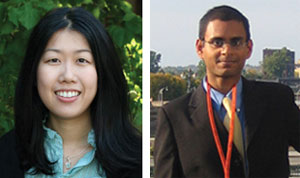
Meredith M. Lee, president of the OSA student chapter at Stanford. Courtesy of M.M. Lee. Ashwin Wagadarikar, president of the OSA student chapter at Duke. Courtesy of A. Wagadarikar.
The kids aren’t the only ones benefiting from the experience – the parents and teachers are, too. In fact, the student chapter has an entire day dedicated to teachers. At this year’s Educators’ Day, the grad students showed how various ordinary objects fluoresce under black light. “There was a teacher with a California [driver’s] license – and out pops the California state flag, and she was just amazed,” Lee said. “She was excited to take that back … to the kids.” (The flag can be used to verify the authenticity of the driver’s license.)
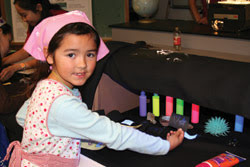
Second-grader Kathryn Lauron of San Francisco demonstrates her invisible ink message under black light. Courtesy of the Stanford student chapter of OSA.
The group has employed a number of innovative tools for reaching out to the community, including broadcasting events on YouTube. Google owns YouTube, and most of the other Internet-based applications used by the Stanford OSA chapter are Google-based, as well. It’s well-known that Larry Page and Sergey Brin founded the company while at Stanford and that the Google headquarters is in the nearby city of Mountain View.
“There are a lot of people at Stanford who are enamored by the Google applications,” Lee said, “We met Larry and Sergey – not through this program, but through the campus, and they’re nice, personable people.”
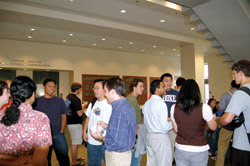
The Duke chapter gathers outside the Fitzpatrick Institute for Photonics during its welcome social. Courtesy of the Duke student chapter of OSA.
Although the program hasn’t invited Larry or Sergey, it has brought the chief technical officer of a trendy solar energy firm, SunPower of San Jose, Calif., to a standing-room-only audience of 200 people.
Lee believes that her chapter, with 75 dues payers and a mailing list of 250 to 300 recipients, has the most members of any in OSA. She joined when she was an undergraduate. “I love teaching,” she said. Besides networking and teaching, she cites another reason to become a member: “It’s just fun.”
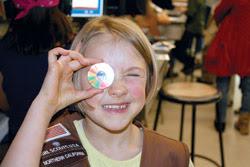
Sage Meadows, a Girl Scout and second-grader from Fairfax, Calif., sees rainbows through a diffraction grating. Courtesy of the Stanford student chapter of OSA.
In January of 2008, she represented her chapter at the International OSA Network of Students (IONS) conference in Munich, Germany. The Stanford chapter often collaborates with other chapters. Lately, the group has been coordinating events with the student chapter at the nearby University of California, Berkeley. The students also get together at the OSA national meeting, Frontiers in Optics.
Duking it out
Meanwhile, at Duke University in Durham, N.C., the OSA student chapter has been hosting events at local schools like Pearsontown Elementary and Sherwood Githens Middle School. The group set up various demonstrations for the kids, among them a fog machine, a telescope and optical illusions. “Seeing the inquisitive and excited kids was really rewarding,” said Ashwin Wagadarikar, president of the Duke chapter.
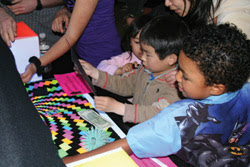
At Stanford’s Community Day, 2000 people interacted with the exhibits set up by the OSA student chapter. Courtesy of the Stanford student chapter of OSA.
The chapter members showed the kids that they could use diffractive optical elements to guide laser pointers, and they evaluated this exercise for an OSA student chapter in Belgium that is developing it into an educational kit for commercial sale.
“Over the course of the semester, we’ve had undergraduate involvement for the first time in our chapter’s history,” Wagadarikar said. Under the guidance of the grad students, the undergraduates have been retrofitting an old projector with an LCD panel, which not only is instructive but also saves money because LCD projectors are “expensive,” he said, adding that the project makes the undergraduates “feel a part of something cool.”
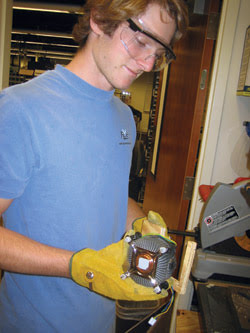
Robby Cochran, a Duke undergraduate student, attaches a fan to cool the LCD as it is back-illuminated by the projector. Courtesy of the Duke student chapter of OSA.
Next year, the students plan to build a “death ray” consisting of a giant Fresnel lens, which can concentrate sunlight so much that it can burn a hole through a penny. These lenses can be ripped out of old TV sets. The group got this idea from a Web site, www.instructables.com.
The graduate students also go on outings, such as a trip to the observatory at the University of North Carolina, Chapel Hill. Later, Ashwin returned to the observatory to remotely operate a telescope in Chile as part of his PhD project, which is to develop hardware and software for clarifying objects in the night sky.
The chapter will host guest speakers such as Brad Bower from Bioptigen and Scott McCain from Applied Quantum Technologies, both Duke spinoff corporations, and Ralph James from Brookhaven National Laboratory.
The chapter was established only five years ago but has 160 people on the mailing list from Duke University’s Fitzpatrick Institute for Photonics. Members of Ashwin’s lab convinced him to join. “I will also treasure the experiences from the leadership conference,” he said, noting “the opportunity to meet people from across the world.”
Growing up OSA style
KiKi L’Italien coordinates the chapters from the organization’s headquarters in Washington. Just this year, L’Italien has seen 36 new OSA student chapters spring up – the largest increase in history.
The previous record was 22, during the telecom boom – only now, there’s no boom. L’Italien believes that the meteoric rise of student chapters this year is directly related to social networking sites like MySpace, Facebook and Twitter. OSA has already approved five new chapters for next year.
“Basically, we’re trying to encourage them to have a professional home,” L’Italien said. “My job is building relationships and providing [members] with an opportunity to get the next job. These are people who are going to be communicating with them through the rest of their careers.”
L’Italien fosters these relationships through meetings, e-mail communication and innovative means like webinars designed for students and through podcasts that began with a student focus. Now the podcasts are designed for a wide audience – anyone interested can listen in.